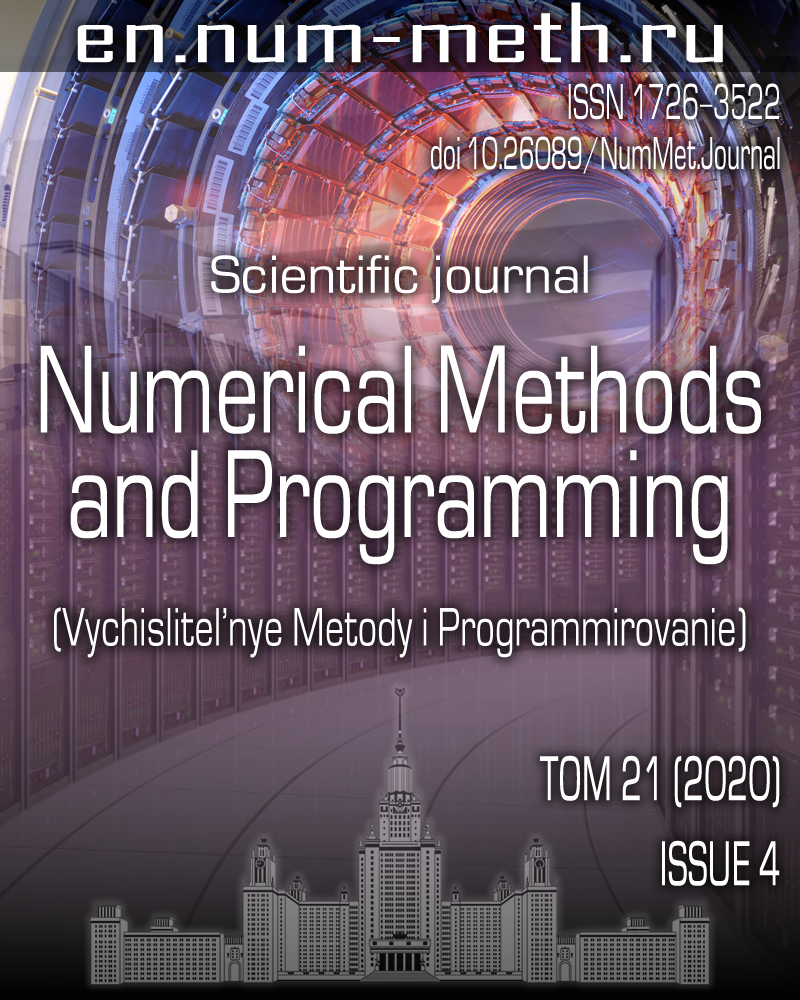DOI: https://doi.org/10.26089/NumMet.v21r435
Study of a mathematical model of gasoline catalytic reforming by sensitivity analysis methods
Keywords:
Abstract
A detailed kinetic model is required to study one of the most important oil refining processes known as catalytic reforming. The difficulty arises in connection with a large number of components of the reaction mixture and a large number of stages of chemical transformations in developing the kinetic model. An alternative may be reduced reaction mechanisms that are applicable to solve the problem and provide a realistic description of the process. In this paper, to analyze the kinetic model and to obtain an abbreviated reaction mechanism, the sensitivity analysis methods of the mathematical model are used. The least influential stages of catalytic reforming of gasoline, which do not affect the general dynamics of changes in the concentrations of significant reaction substances are identified using this technique. The effect of eliminating these stages on the kinetics of the process from the chemical point of view is analyzed. A reduced scheme for catalytic reforming of gasoline by excluding these stages is proposed. A reduced scheme provides a quite satisfactory agreement both in temperature profiles and in concentration profiles of significant substances.
Published
Issue
Section
References
- R. Z. Zainullin, K. F. Koledina, A. F. Akhmetov, and I. M.Gubaidullin, “Possible Ways of Upgrading Reactor Unit of Catalytic Reforming Based on Kinetic Model,” Elektron. Nauch. Zh. Neftegazovoe Delo, No. 6, 78-97 (2018).
- M. Z. Stijepovic, A. Vojvodic-Ostojic, I. Milenkovic, and P. Linke, “Development of a Kinetic Model for Catalytic Reforming of Naphtha and Parameter Estimation Using Industrial Plant Data,” Energy Fuels 23 (2), 979-983 (2009)
- O. A. Stadnichenko, L. F. Nurislamova, N. S. Masyuk, et al., “Radical Mechanism for the Gas-Phase Thermal Decomposition of Propane,” Reac. Kinet. Mech. Cat. 123 (2), 607-624 (2018).
- Z. Qin, V. V. Lissianski, H. Yang, et. al., “Combustion Chemistry of Propane: A Case Study of Detailed Reaction Mechanism Optimization,” Proc Combust Inst. 28 (2), 1663-1669 (2000).
- T. Lu and C. K. Law, “Toward Accommodating Realistic Fuel Chemistry in Large-Scale Computations,” Prog. Energy Combust. Sci. 35 (2), 192-215 (2009).
- C. K. Law, C. J. Sung, H. Wang, and T. F. Lu, “Development of Comprehensive Detailed and Reduced Reaction Mechanisms for Combustion Modeling,” AIAA J. 41 (9), 1629-1646 (2003).
- L. F. Nurislamova and I. M. Gubaydullin, “Mechanism Reduction of Chemical Reaction Based on Sensitivity Analysis: Development and Testing of Some New Procedure,” J. Math. Chem. 55 (9), 1779-1792 (2017).
- L. F. Safiullina, I. M. Gubaydullin, R. M. Uzyanbaev, and A. E. Musina, “Computational Aspects of Simplification of Mathematical Models of Chemical Reaction Systems,” J. Phys.: Conf. Ser. 1368 (2019).
doi 10.1088/1742-6596/1368/4/042022 - D. Iranshahi, S. Amiri, M. Karimi, et al., “Modeling and Simulation of a Novel Membrane Reactor in a Continuous Catalytic Regenerative Naphtha Reformer Accompanied with a Detailed Description of Kinetics,” Energy Fuels 27 (7), 4048-4070 (2013).
- R. Z. Zainullin, K. F. Koledina, A. F. Akhmetov, and I. M. Gubaidullin, “Kinetics of the Catalytic Reforming of Gasoline” Kinet. Catal. 58, 279-289 (2017).
- B. C. Gates, J. R. Katzer, and G. C. A. Shuit, Chemistry of Catalytic Processes (McGraw-Hill, New York, 1979; Mir, Moscow, 1981).
- T. Ikonen and V. Tulkki, “The Importance of Input Interactions in the Uncertainty and Sensitivity Analysis of Nuclear Fuel Behavior,” Nucl. Eng. Des. 275, 229-241 (2014).
- A. S. Tomlin, T. Turányi, and M. J. Pilling, “Mathematical Tools for the Construction, Investigation and Reduction of Combustion Mechanisms,” in Comprehensive Chemical Kinetics (Elsevier, New York, 1997), Vol. 35, pp. 293-437.
- M. S. Okino and M. L. Mavrovouniotis, “Simplification of Mathematical Models of Chemical Reaction Systems,” Chem. Rev. 98 (2), 391-408 (1998).
- L. S. Polak, M. Ya. Goldenberg, and A. A. Levitskii, Computational Methods in Chemical Kinetics (Nauka, Moscow, 1984) [in Russian].
- A. Saltelli, M. Ratto, S. Tarantola, and F. Campolongo, “Sensitivity Analysis for Chemical Models,” Chem. Rev. 105 (7), 2811-2828 (2005).
- T. Turányi, “Sensitivity Analysis of Complex Kinetic Systems. Tools and Applications,” J. Math. Chem. 5 (3), 203-248 (1990).


